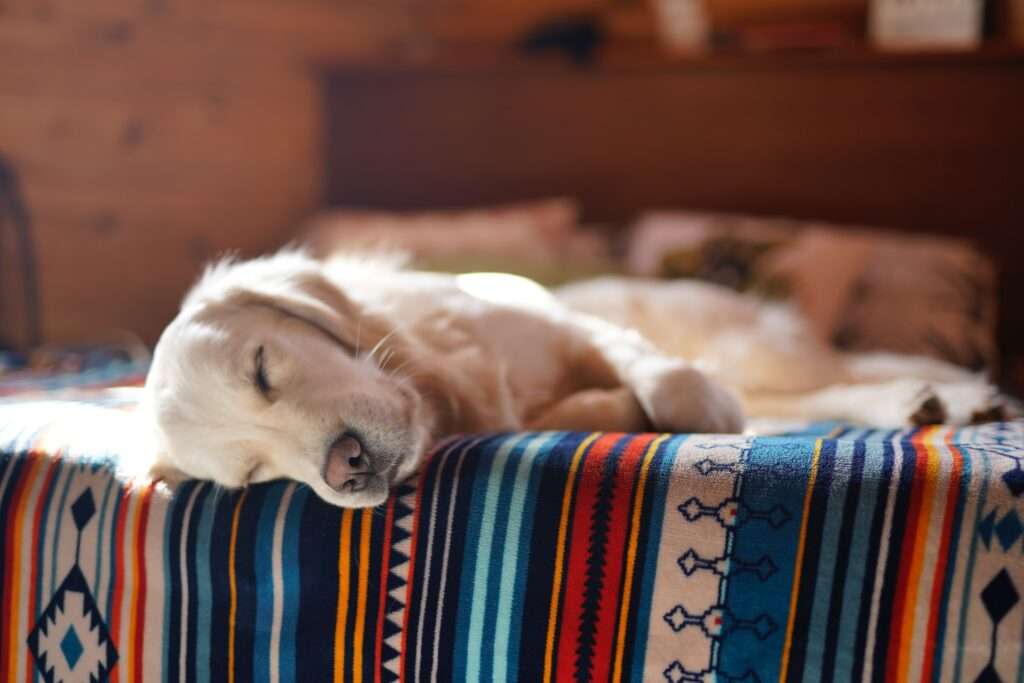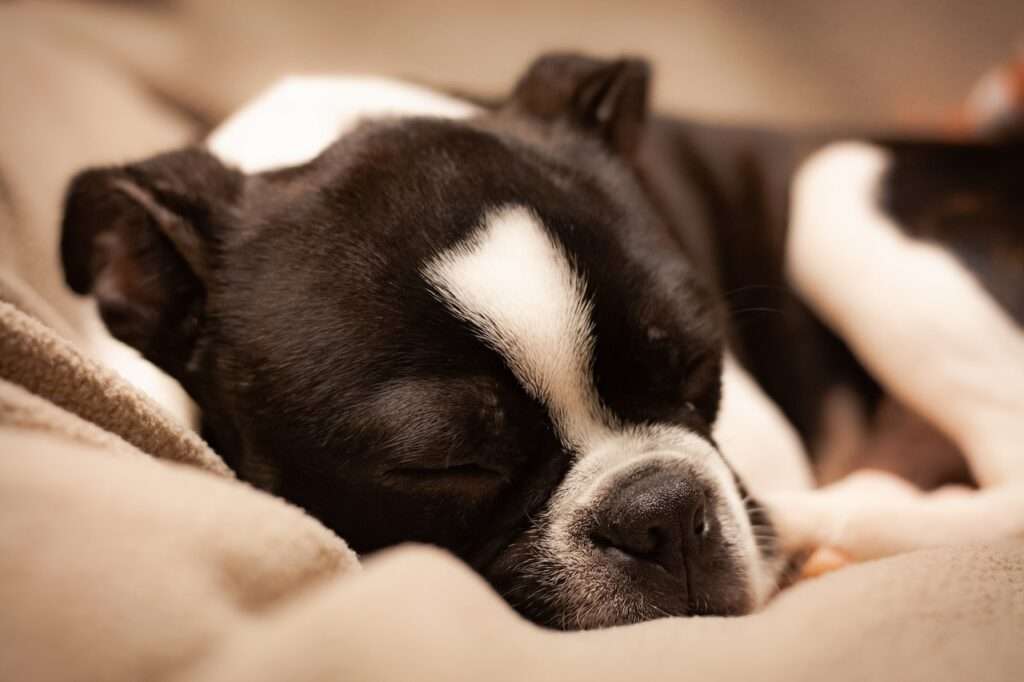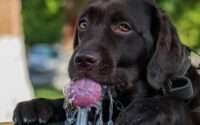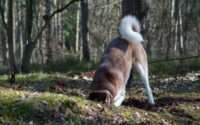Is Your Dog Twitching in Sleep? Here’s What You Need to Know
As a dog owner, you’ve likely noticed your furry friend twitching and moving in their sleep. While it may be concerning to see your beloved pet in what appears to be distress, rest assured that dog twitching in sleep is a common and completely normal behavior. In fact, it’s a sign that your dog is getting the restful sleep they need to stay healthy and happy.
In this article, we’ll take a closer look at a dog twitching in sleep, including what causes it, the different types of twitching you may notice, and when to be concerned. We’ll also provide some tips for helping your dog get the best possible sleep. So, whether you’re a seasoned dog owner or a first-time pet parent, read on to learn everything you need to know about your dog twitching in sleep!
What is Dog Twitching in Sleep?
Dogs are known to be heavy sleepers, often sleeping up to 12-14 hours a day. It’s not uncommon to see your dog twitching or moving around during their sleep. But what causes dogs to twitch in their sleep? Is it normal or should you be concerned?
Dog twitching in sleep refers to involuntary muscle contractions or movements that occur during your dog’s sleep. These movements can range from small twitches to more noticeable jerking motions. Twitching is more commonly seen during the rapid eye movement (REM) stage of sleep, which is when dogs are most likely to be dreaming.
It’s important to note that twitching during sleep is usually not harmful or painful to dogs. In fact, it’s a completely normal behavior that can occur in all breeds of dogs.
Why Do Dogs Twitch in Their Sleep?

If you’ve ever observed your dog twitching or moving during sleep, you may have wondered what’s happening inside their adorable furry head. At BarkLikeMeow, we’re here to shed light on the fascinating phenomenon of dog twitching in sleep and explore the scientific explanations behind it.
- Stages of Sleep: Dogs, like humans, experience different stages of sleep, each with its own distinct characteristics. The first two stages are non-rapid eye movement (non-REM) sleep. In these stages, dogs are in a lighter sleep, and they can be easily awakened. The third stage is deep sleep, where dogs are in their most restorative slumber. And then, there’s the rapid eye movement (REM) stage, which is when the most intriguing things happen.
- The REM Stage: During the REM stage of sleep, dogs enter a phase where their brains are highly active and dreams occur. It’s in this stage that dogs are most likely to twitch, move their legs, wag their tails, or even make adorable sounds. These actions often mirror the content of their dreams, whether they’re happily chasing squirrels, playing with their best furry friends, or embarking on grand adventures.
- Dreaming Doggy Brains: Research suggests that dogs have complex dreams, just like humans. Their dream experiences may involve reliving past experiences, processing emotions, or engaging in imaginary scenarios. The twitching and movements during sleep are thought to be a physical manifestation of these dream-like activities. It’s as if they’re participating in their own whimsical canine theater!
- Breed Variations: It’s important to note that different dog breeds may exhibit varying degrees of twitching during sleep. Some breeds, like Pointers or Retrievers, might have more pronounced movements, while others may have subtler twitches. These variations are part of the unique tapestry of your dog’s breed-specific sleep patterns and personalities.
- Age and Sleep Behavior: Younger dogs and puppies tend to have more frequent sleep and intense movements. As they grow and mature, their sleep patterns often become more subdued. So, if you’ve noticed your playful pup twitching more in their sleep, it’s likely a reflection of their youthful energy and active dream cycles.
While twitching during sleep is generally harmless and a natural part of your dog’s sleep cycle, there are some instances where it may be a cause for concern. If your dog consistently experiences violent or excessive twitching that disrupts their sleep or is accompanied by other worrisome symptoms, it’s wise to consult with your veterinarian to rule out any underlying health issues.
Common Types of Twitching
When it comes to our furry companions, watching them twitch and move during sleep can be both entertaining and endearing. These adorable sleep twitches can come in various forms, each offering a glimpse into the captivating world of dog dreams. Here are some common types of twitching you may observe in your dog during their slumber.
- Rapid Eye Movements (REMs): REMs are a fascinating characteristic of the sleep cycle where dreams are most likely to occur. During this stage, you may notice your dog’s eyes moving rapidly beneath their closed eyelids. These eye movements indicate that your pup is actively engaged in a dream, chasing squirrels, frolicking in the park, or engaging in other exciting adventures. It’s a visual cue that their imagination is running wild!
- Paw Paddling: Ever witnessed your dog’s paws moving rhythmically as if they’re playfully running in their sleep? This charming behavior, known as paw paddling, is quite common during doggy dreams. It’s as if they’re relishing the exhilaration of a joyful chase, envisioning themselves sprinting after a ball or bounding through fields of flowers. Paw paddling is a delightful reminder of the active and playful nature of our canine companions.
- Vocalizations and Noises: Dogs are known to express themselves through vocalizations, and this extends to their sleep as well. You may hear your dog softly whimpering, barking, or even howling during their slumber. These vocalizations are closely tied to their dream experiences and can range from gentle murmurs to enthusiastic barks. It’s their way of participating in their dreams, whether they’re alerting the world to an imaginary squirrel or serenading the moon.
It’s essential to remember that these types of twitching are typically harmless and a natural part of your dog’s sleep patterns. They signify that your pup’s brain is actively processing information, consolidating memories, and engaging in their own captivating dreamscapes.
While it’s tempting to wake your dog during these dreamy episodes, it’s generally best to allow them to continue their uninterrupted slumber. Interrupting their sleep may disorient them and hinder their natural sleep cycles. Instead, cherish these precious moments and take joy in the fact that your furry friend is experiencing their own imaginative journeys.
When to Be Concerned About Twitching
While twitching in sleep is generally nothing to worry about, there are some instances where it may indicate an underlying health problem. If you notice any of the following red flags, it’s important to contact your veterinarian:
- Extended Duration: If your dog’s twitching persists for an unusually long period, lasting several minutes or more, it’s wise to contact your veterinarian. Prolonged twitching may indicate an underlying issue that requires professional evaluation.
- Abnormal Vocalizations: Pay attention if your dog’s twitches are accompanied by abnormal vocalizations, such as yelping, crying, or distressful noises. These vocal cues can be indicators of discomfort or pain, warranting a closer examination by a veterinary professional.
- Twitching While Awake: If your dog exhibits twitching behaviors during periods when they’re not sleeping, it may be worth investigating further. Twitching that occurs while awake could be a sign of an underlying neurological or muscular condition that requires attention.
- Additional Signs of Illness: Take note if the twitching is accompanied by other signs of illness, such as lethargy, loss of appetite, or changes in behavior. These symptoms, when combined with twitching, could point to an underlying health problem that requires a veterinary examination.
In rare cases, twitching in sleep may indicate that your dog is experiencing seizures. Seizures are a serious medical condition that require immediate veterinary attention. Overall, while twitching in sleep is usually nothing to worry about, it’s important to pay attention to your dog’s behavior and contact your veterinarian if you notice anything unusual.
How to Help Your Dog Sleep Better

Just like us, our canine companions deserve a good night’s sleep to wake up refreshed and ready for a new day of adventures. If your dog’s frequent twitching during sleep has you wondering if they’re getting the rest they need, fret not! Here are some tips to help your furry friend sleep better and experience the blissful slumber they deserve.
- Create a Comfortable Sleeping Environment: Provide your dog with a cozy and inviting sleeping space. A comfortable bed or cushion in a quiet, dark room can work wonders. Consider adding a touch of serenity with a white noise machine or a gentle aroma of calming scents, such as lavender, to help create a tranquil atmosphere that promotes relaxation.
- Stick to a Routine: Dogs thrive on routine and find comfort in predictability. Establishing a consistent schedule for feeding, exercise, and bedtime can help regulate their internal clock. Aim to feed your dog at regular times, engage in exercise or play sessions at predictable intervals, and establish a bedtime routine that signals it’s time to wind down. A structured routine can help your dog anticipate and prepare for sleep, ensuring a smoother transition into dreamland.
- Provide Plenty of Exercise: Regular exercise is essential for your dog’s overall well-being and can contribute to better sleep. Engage in daily activities that allow your dog to expend their energy, such as brisk walks, runs, or playtime in the yard. Tailor the exercise routine to your dog’s breed, age, and health condition, ensuring they get the physical and mental stimulation needed to tire them out for a restful night’s sleep.
- Limit Stimulation Before Bedtime: As bedtime approaches, it’s crucial to create a calm and peaceful environment to help your dog wind down. Avoid engaging in high-energy play or stimulating activities in the hours leading up to bedtime. Instead, opt for quiet activities like gentle grooming or a relaxing massage to help your dog relax and prepare for sleep. Dim the lights, lower the volume of the surroundings, and create a serene atmosphere conducive to peaceful slumber.
Remember, each dog is unique, and it may take some trial and error to find the strategies that work best for your furry friend. Be patient and observant, paying attention to your dog’s reactions and behaviors to determine what helps them sleep better.
Conclusion
Understanding your dog’s sleep patterns, including the occasional twitching, is an essential part of being a responsible and caring pet parent. As we’ve explored, twitching in sleep is typically a normal behavior that occurs during the REM stage, indicating vivid dreams and active brain activity.
While most twitching is harmless, it’s crucial to stay vigilant and recognize when it may be a cause for concern. By being attuned to any unusual or prolonged twitching, accompanying symptoms, or changes in behavior, you can take the necessary steps to seek veterinary guidance and address any underlying health issues.
Creating a sleep-friendly environment for your dog is key to promoting restful slumber. Offering a cozy bed in a quiet, dark room, incorporating soothing elements like white noise or calming scents, and maintaining a consistent routine can help set the stage for a peaceful night’s sleep.
Regular exercise is a vital component of your dog’s overall well-being and can contribute to better sleep quality. Engaging in activities that match your dog’s energy levels, breed, and age helps them expend excess energy, leading to a deeper and more satisfying sleep.
Every dog’s comfort and sleep needs may vary, so it’s essential to pay attention to their individual preferences and adjust accordingly. Open communication with your veterinarian ensures that you’re providing the best care for your beloved companion, as they can offer personalized guidance and address any specific concerns.
Frequently Asked Questions
Q: Is it normal for dogs to twitch or move in their sleep?
A: Yes, it is perfectly normal for dogs to twitch, move, or make small involuntary movements while they sleep. Just like humans, dogs experience different stages of sleep, including rapid eye movement (REM) sleep, during which they may exhibit muscle twitches or dream-like movements.
Q: Why do dogs twitch or kick their legs during sleep?
A: Dogs often twitch or kick their legs during sleep due to the activation of their muscles during REM sleep. This stage is associated with increased brain activity and dreaming. The twitches and movements are believed to be a result of the dog’s brain processing and reacting to dream-like experiences.
Q: Should I be concerned if my dog twitches excessively or violently during sleep?
A: While occasional twitching or mild movements are generally considered normal, excessive or violent twitching could be a cause for concern. If you notice persistent or intense twitching that seems to disturb your dog’s sleep or if it is accompanied by other worrisome symptoms, it is advisable to consult a veterinarian to rule out any underlying health issues.
Q: Can certain factors trigger more frequent or intense twitching in dogs?
A: Yes, there are a few factors that can contribute to more frequent or intense twitching in dogs. These may include the dog’s age, breed, size, and overall health. Additionally, external stimuli such as noises, smells, or physical discomfort can influence the intensity of twitching during sleep.
Q: Can dogs have nightmares like humans?
A: It is believed that dogs can have dream-like experiences during REM sleep, which could potentially include both pleasant and unpleasant scenarios. While it is challenging to determine whether a dog is experiencing a nightmare specifically, it is possible that some dogs may exhibit signs of distress, such as vocalizing or restless movements, during sleep.
Q: Should I wake up my dog if they are twitching or having a bad dream?
A: It is generally not recommended to wake up a dog during sleep, even if they are twitching or having a bad dream. Interrupting their sleep can be disorienting and may cause temporary confusion or distress. It is usually best to allow dogs to naturally wake up on their own, unless they are experiencing a severe episode or seizure-like activity.
Remember, while this information provides general insights into dog twitching during sleep, it’s always best to consult with a veterinarian if you have specific concerns about your dog’s behavior or health.




